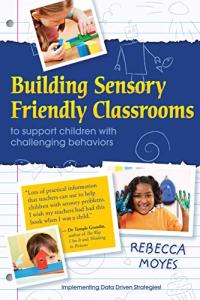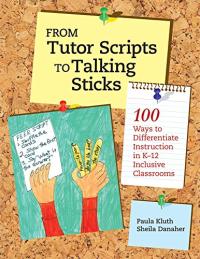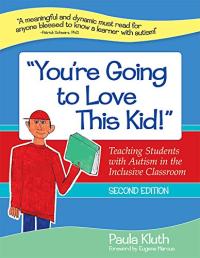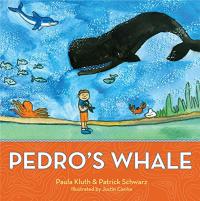
One look at the table of contents and you’ll likely recognize behaviors you deal with on a daily basis like “Bumping Into Other Students,” “Breaking Pencils” and “Difficulty Lining Up.” The solutions are practical and positive and explain the reasons behind the sometimes challenging behavior. Written by a pediatric occupational therapist, a parent of a child with autism and a director of special education, this guide has practical tips for teaching students with autism. This book is designed to be an at-your-fingertips resource. You can quickly consult the table of contents to find the section on the issue, learn what is potentially at the root of the behavior, and find possible solutions to implement immediately.
Behavior Solutions for the Inclusive Classroom

This New York Times best-selling memoir offers a sometimes humorous, sometimes heartbreaking look at what it’s like to grow up with Asperger’s syndrome in a time before there was much understanding of Asperger’s or autism. The author’s stories of his childhood will offer some understanding when it comes to some of the things your students with autism might be feeling and experiencing. You might find yourself laughing as you read the author’s anecdotes about his efforts to navigate the adult world as a person with Asperger’s.
Look Me in the Eye: My Life With Asperger’s

You’re guaranteed to find workable solutions for your classroom in this book of 1,001 (actually 1,800) ideas for working with kids who have autism or Asperger’s. It includes sections for helping with sensory integration, ideas for supporting communication and language, tips for managing challenging behavior, ideas for teaching daily living skills, and strategies for teaching social skills. You can look through the table of contents, target the issue you need to address and find a variety of potential solutions. This book has won numerous awards and is a must-have reference tool for your classroom bookshelf.
1001 Great Ideas for Teaching and Raising Children with Autism or Asperger’s

Temple Grandin may be the most famous person with autism. Weaving her own experience with remarkable new discoveries, Grandin introduces the advances in neuroimaging and genetic research that link brain science to behavior, even sharing her own brain scan to show which anomalies might explain common symptoms. She argues that raising and educating kids on the autism spectrum must focus on their long-overlooked strengths to nurture their unique contributions. Grandin discusses different ways of thinking and even includes lists of potential jobs for those people among us who think differently. An important and ultimately optimistic work.
The Autistic Brain: Helping Different Kinds of Minds Succeed

This groundbreaking book by Dr. Temple Grandin, professor of animal science at Colorado State University, was one of the first to help neurotypical adults understand autism from a first-person point of view. She gives you a peek into her own psyche to help you understand how your child or students with autism might process information. Her explanation of how she sees the world in pictures will change how you relate to people with autism. Temple offers helpful dos and don’ts, practical strategies, and try-it-now tips, all based on her insider perspective and a great deal of research.
The Way I See It: A Personal Look at Autism and Asperger’s

Teachers know that half the challenge of teaching is setting up an effective learning environment. This book is designed to help you structure your classroom so that even kids who struggle with sensory overload (like many kids with autism do) will feel comfortable. The author places an emphasis on using data from student observations to craft a classroom that will support your specific students and their needs.
Building Sensory Friendly Classrooms to Support Children with Challenging Behaviors

An an essential “literacy meets autism” primer for general educators and reading specialists, this book provides the know-how for bringing quality, meaningful literacy instruction to students with autism in grades K-12. Teachers will learn research-based practices in reading and writing instruction; ideas for planning lessons, differentiating instruction, and designing a classroom environment that promotes literacy learning while addressing the individual needs of learners with autism; techniques for assessing students who cannot show their literacy learning in traditional ways due to communication or learning differences; and much more from the authors’ own extensive classroom experience.
A Land We Can Share: Teaching Literacy to Students with Autism

When learners with autism have deep, consuming fascinations — trains, triangles, basketballs, whales — teachers often wonder what to do. This concise, highly practical guidebook gives educators across grade levels a powerful new way to think about students’ “obsessions” — as positive teaching tools that calm, motivate, and improve learning. Written by top autism experts and nationally renowned speakers Kluth and Schwarz, this guide is full of easy tips and strategies for folding students’ special interests, strengths, and areas of expertise into classroom lessons and routines.
Just Give Him the Whale! 20 Ways to Use Fascinations, Areas of Expertise, and Strengths to Support Students with Autism

These ready-to-use, research-based adaptations enhance motivation and improve achievement for all children — including English-language learners and students with autism, emotional disabilities, cognitive disabilities, learning disabilities and other special needs. Includes easy adaptations in 10 key areas: organization; environment and sensory; technology; communication and participation; behavior and motivation; teaching and learning; literacy; math; study and review; and assessment
From Tutor Scripts to Talking Sticks: 100 Ways to Differentiate Instruction in K-12 Inclusive Classrooms

Find fresh ways to welcome and teach students with autism. The book includes forms, checklists, and planning tools that make it easy for teachers to implement the suggested strategies; photos of curricular adaptations, sensory supports, and classroom scenes; and tips on improving literacy, implementing positive behavior support, and collaborating effectively with families. This updated edition also includes information on fostering friendships, building communication skills, planning challenging and multidimensional lessons, and adapting the curriculum and the physical environment.
You’re Going to Love This Kid! Teaching Students with Autism in the Inclusive Classroom

Psychologist and educator Armstrong illuminates a new understanding of neuropsychological disorders. He argues that if they are a part of the natural diversity of the human brain, they cannot simply be defined as illnesses. Armstrong explores the evolutionary advantages, special skills, and other positive dimensions of these conditions. A manifesto as well as a keenly intelligent look at “disability,” this book is an important read for parents, teachers, and anyone who is “differently brained.”
The Power of Neurodiversity: Unleashing the Advantages of Your Differently Wired Brain

This book offers a deep understanding and a more humane approach to autism. Instead of classifying “autistic” behaviors as signs of pathology, autism expert Dr. Prizant sees them as part of a range of strategies to cope with a world that feels chaotic and overwhelming. Rather than curb these behaviors, it’s better to enhance abilities, build on strengths, and offer supports that will lead to more desirable behavior and a better quality of life. “This is by far the most empathic, wise, and insightful book I have ever read about autism, and is one of the most empathic and wise books I’ve ever read about being human.”
Uniquely Human: A Different Way of Seeing Autism

This best-selling book tells the story of Leo Kanner and Hans Asperger, the research pioneers who defined the scope of autism in profoundly different ways; and then goes on to explore the game-changing concept of neurodiversity. It considers the idea that neurological differences such as autism, dyslexia, and ADHD are not errors of nature or products of the toxic modern world, but the result of natural variations in the human genome. This groundbreaking book will reshape our understanding of the history, meaning, function, and implications of neurodiversity in our world.
NeuroTribes: The Legacy of Autism and the Future of Neurodiversity

Imagine being trapped inside a Disney movie and having to learn about life mostly from animated characters dancing across a screen of color. A fantasy? A nightmare? This is the real-life story of Owen Suskind, the son of the Pulitzer Prize-winning journalist Ron Suskind and his wife, Cornelia. An autistic boy who couldn’t speak for years, Owen memorized dozens of Disney movies, turned them into a language to express love and loss, kinship, brotherhood.The family was forced to become animated characters, communicating with him in Disney dialogue and song; until they all emerge, together, revealing how, in darkness, we all literally need stories to survive.
Life, Animated: A Story of Sidekicks, Heroes, and Autism

A great resource for educators, behavior specialists, early interventionists, SLPs, occupational therapists, and families, this reader-friendly pocket guide is the perfect introduction to Pivotal Response Treatment (PRT), the popular approach that uses natural learning opportunities to modify pivotal areas of behavior. Pioneering autism experts Robert and Lynn Koegel speak directly to the reader, demystifying PRT and clearly explaining why it leads to widespread and rapid progress for children.
The PRT Pocket Guide: Pivotal Response Treatment for Autism Spectrum Disorders

With an estimated half a million Americans under twenty-six on the autism spectrum, this book offers the reassurance, solace, and practical solutions that so many people are searching for. Following up on their work in Overcoming Autism, which offered advice for teaching young children on the spectrum, Koegel and LaZebnik now present strategies for working with teens and young adults living with this complex condition. The book addresses universal parental concerns, from first crushes and a changing body to how to succeed in college and beyond,
Growing Up on the Spectrum: A Guide to Life, Love, and Learning for Teens and Young Adults with Autism and Asperger’s

Lynn Kern Koegel, the nationally recognized head of the Autism Research Center at the University of California, and Claire LaZebnik, a professional writer and the mother of a child with autism, have updated their classic guide with today’s cutting-edge research. This revised edition has also been expanded to clarify the importance of community support to affected families and the effect of societal acceptance on a child’s life.
Overcoming Autism: Finding the Answers, Strategies, and Hope That Can Transform a Child’s Life

When young Temple was diagnosed with autism, no one expected her to talk, let alone become one of the most powerful voices in modern science. Yet, the determined visual thinker did just that. Her unique mind allowed her to connect with animals in a special way, helping her invent groundbreaking improvements for farms around the globe. Also included are fun facts, a timeline of events, and a note from Temple.
The Girl Who Thought in Pictures: The Story of Dr. Temple Grandin

When Temple Grandin was born, her parents knew that she was different. Years later she was diagnosed with autism. Her mother believed in her abilitie and supported her education, and Temple eventually went on to graduate school. Today, Dr. Temple Grandin is a scientist and professor of animal science at Colorado State University. Through her work she revolutionized the livestock industry. As an advocate for autism, Temple uses her experience as an example of the unique contributions that autistic people can make. This biography, complete with personal photos, takes us inside Temple’s extraordinary mind and opens the door to a broader understanding of autism.
Temple Grandin: How the Girl Who Loved Cows Embraced Autism and Changed the World

“Ezra looks like any other sixth grader with faded jeans, turned around cap and a mess of chestnut curls. You see, my brother is like any other eleven-year-old except when he isn’t.” This story follows 14-year-old Jenny as she describes her day-to-day life with her younger autistic brother, Ezra. Ezra can be both her best friend as well as her biggest obstacle to living a normal life, and Jenny often finds herself stuck worrying about her younger brother. Through taking care of Ezra and a very special school project, Jenny ends up learning about her own character and strengths, and a way to shine despite everything else.
Autism, the Invisible Cord: A Sibling’s Diary

Pedro, a young boy who loves whales more than anything, is heartbroken when he’s told to put away his favorite toy whale on the first day of school. But then Pedro’s teacher discovers the secret to helping him do his best work: not only giving him his whale, but also incorporating his special interest into the whole curriculum. Soon, Pedro’s whale is helping all the children learn, as the teacher works whales into math lessons, storytime, simple science experiments, and more! Pedro’s whale helps him make friends, too, as the other children start to share his special interest.
Pedro’s Whale

Louis, a self-taught space expert is delighted to learn that his teacher has sent him to the principal’s office to attend personal space camp. Eager to learn more about lunar landings, space suits, and other cosmic concepts, Louis soon discovers that he has much to learn about personal space right here on earth. Written with style, wit, and rhythm, personal space camp addresses the complex issue of respect for another person’s physical boundaries. Told from Louis’s perspective, this story is a good resource for parents, teachers, and counselors who want to communicate the idea of personal space in a manner that connects with kids.
Personal Space Camp

All of Louis thoughts are very important to him. In fact, his thoughts are so important to him that when he has something to say, he erupts, or interrupts others. His mouth is a volcano! This story takes an empathetic approach to the habit of interrupting and teaches children a witty technique to capture their rambunctious thoughts and words for expression at an appropriate time. Told from Louis’s perspective, the story provides parents, teachers, and counselors with an entertaining way to teach children the value of respecting others by listening and waiting for their turn to speak.
My Mouth Is a Volcano!

NO is RJ s least favorite word … and he tries his best to convince his dad, his mom, and his teacher to turn No into Maybe or We’ll see or Later or I’ll think about it. Even though he doesn t have much success, RJ keeps arguing until his teacher suggests that he try to join her classroom s Say YES to NO Club. If RJ can learn how to accept No for an answer and to disagree appropriately with his teacher and parents, he can add his name to the club’s Star Board.
